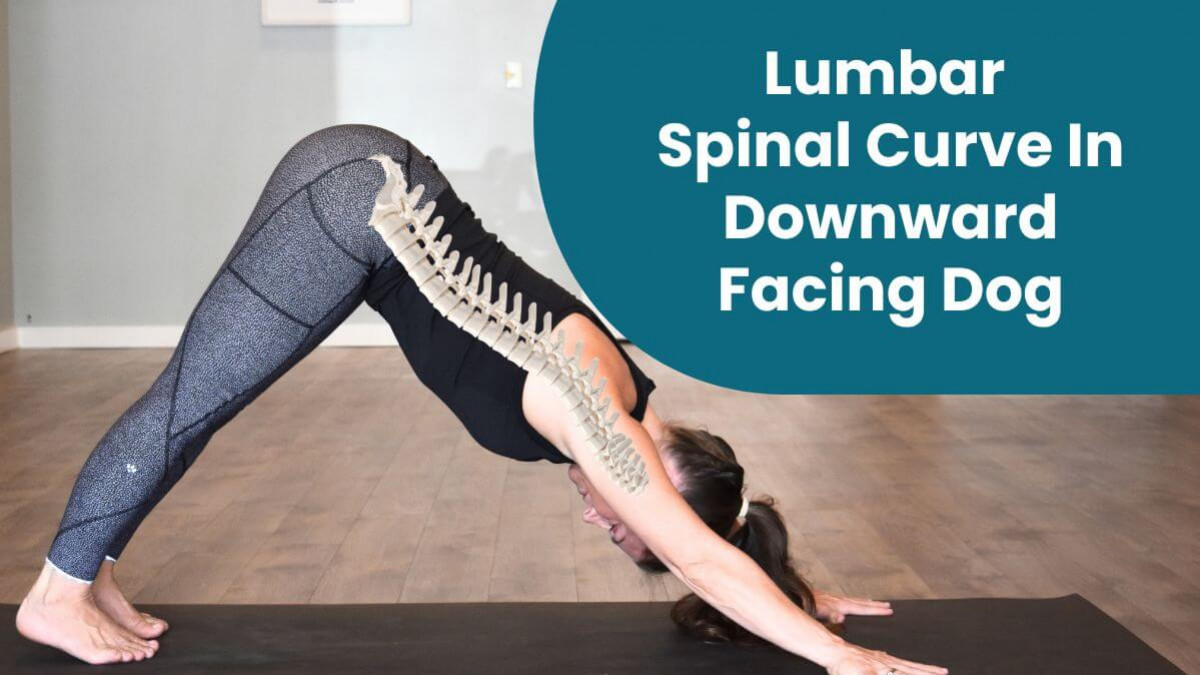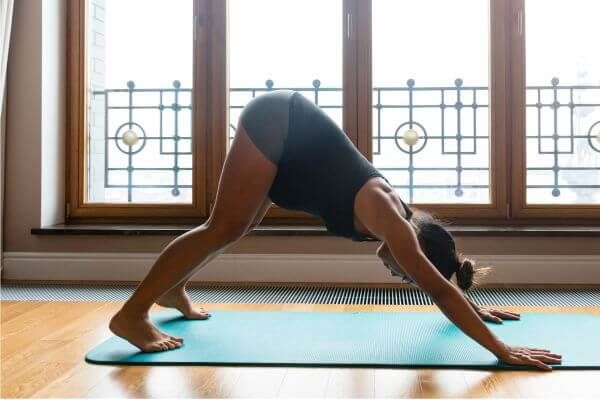Keep the Lumbar Curve in Downward Facing Dog

Provide cues to keep the lumbar curve in downward facing dog and learn why this is so important.
Keep The Lumbar Curve Present In Downward Facing
.
Maintaining spinal curves in yoga can improve students' health and enhance the effectiveness of classes. In this blog post, we will discuss the benefits of spinal curves in yoga, the lumbar curve, and how to help students access the lumbar curve in downward facing dog. Read on if you want to teach yoga with more confidence and help your students feel more strength and ease in their practice.
.
Understand the Anatomy of the Spinal Curves

There are three natural curves of the spine, namely, lumbar curve, thoracic curve, and cervical curve. The directions of the curves alternate and ultimately create a S shape.
The S shape of the spine provides a very supportive structure and the curves allow the spine to absorb high levels of shock. In infancy, the spine is C - shaped. A large component of physical development is the transtion from a C shaped spine to an S shape spine. The S shape begins to take form through physical activity. As babies start to push against the floor to lift their heads, roll, and eventually crawl, the strength of the core muscles improves. As the muscles pull on the spine, the curves develop. The eventual S shape prepares babies for walking and higher level functional activities.
Maintaining these spinal curves in yoga has numerous benefits like improving overall strength and flexibility, improved postural alignment, increased core strength, balance, and stability. This helps reduce stress on the body by evenly distributing weight and pressure, promotes breath control and improves circulation throughout the body!
The cervical curve is found in the neck, supporting the head when looking up or down. The thoracic curve is located in the mid-back region. The thoracic curve is important for keeping balance and allowing for optimal expansion of the rib cage. That is, the thoracic curve helps with breath!
.

.
Understanding the Lumbar Curve for Improved Yoga Practice
The lumbar curve is located in the lower back region and consists of 5 large vertebrae. The lumbar curve helps in supporting the upper body's weight.
.
Optimal alignment of the spine results in a slightly arched forward curve with flexibility throughout its range of motion, allowing for free movement throughout various yoga postures without straining or overstretching the lower back muscles.
.
An optimal lumbar curvature helps prevent pain and injury during practice. When the lumbar curve is compromised, so are the mechanics of the thoracic and lumbar spine. This serves good reason to keep the lumbar curve present with sitting, standing, and practicing yoga postures!!
.

.
With forward bends and backbends, the curves of the spine will, of course, change. For example, with a standing forward fold you can expect to see the lumbar curve reverse. With an expansive backbend such as wheel, you can expect to see an increase in the lordotic curve of the lumbar spine. These dynamic changes in the position of the spine are healthy. There is some research that suggests that a regular physical yoga practice has a positive impact on posture including more optimally aligned lumbar curve. So keep doing forward bends and backbends.
.
Is Downward Facing Dog a Backbend or Forward Bend?
.

.
Downward facing dog is neither a forward bend or backward bend. While the hips are in flexion, down dog is a great pose to access a neutral spine. But a lot of yoga teachers and practitioners are missing this.
.
I often see people practicing downward facing dog with a reversal of the lumbar lordosis. This is what we expect to see in forward folds. But why is is often happening in downward facing dog?
.

.
One of the most common reasons for the lumbar curve to be reversed in downward facing dog is decreased mobility at the hips. They may be due to the bony structure of the hip joint. It is more commonly a result of decreased mobility of the soft tissues, especially the hamstrings. So here’s an easy tip. Tell your students to bend their knees!

.
.
The hamstrings are the muscles in the back of the legs that attache from your sit bones (ischial tuberosities) to the lower leg bones (tibia and fibular). In other words, the hamstrings attach to the pelvis and cross the hip joint and the knee joint. If there is not a enough flexibility in the hamstrings to cross both these joints, they will pull the pelvis into a posterior tilt. . A neutral pelvis is important for creating a stable foundation for the curves of the spine. [Refer to prior article "Neutral Pelvis in Yoga is Bio-mechanical Magic!] Bending the knees allows the hamstrings to have some "slack" at the knee joint. This results in less pull on the pelvis, ultimately making it easier to obtain a neutral pelvis and lumbar lordosis in the spine.
.

Another common reason for a reversal of the lumbar spinal curve in yoga postures such as downward facing dog, is a high level of mobility throughout the spine and body.
.

.
I often hear yoga teachers cue students to press their chest towards their thighs in downward facing dog. While this may be appropriate for some students, it's impact on hypermobile people is often a loss of teh natural curves of the spine. Both the lumbar lordosis and thoracic kyphosis get reversed. Such students would benefit more from cues to engage the muscles that would help reverse the curve. One such cue could be to "Draw the front ribs in towards each other." This will activate the abdominals and help restore the thoracic kyphosis. Restoration of the thoracic kyphosis could lead to restoration of the lumbar lordosis.
.
In Yoga Anatomy School's Foundations Course, we focus on Optimal Postural Alignment of the spine and body. If you want a simplified process for assessing your students' alignment in any yoga pose AND to know how to confidently cue them to get the most out of their practice, the Foundations Course is for you!!

Module 7 of The Foundations Course covers the anatomy of the lumbar and thoracic spine. Learn the anatomy and how to cue your students to align their spine in any yoga pose!

All 14 modules of the Foundations Course are available inside the Yoga Anatomy School Membership!

Sign up for our Yoga Anatomy course today and become a knowledgeable teacher who can make a real difference!
Categories: : Posture Alignment, Yoga Anatomy, Spine
I have read and agree to the terms & conditions.
 Trish Corley
Trish Corley 



